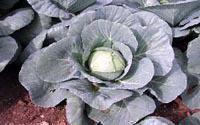Resource Library
Plant of the Week: Cabbage
The University of Arkansas System Division of Agriculture does not promote, support or recommend plants featured in "Plant of the Week." Please consult your local Extension office for plants suitable for your region.
Plant of the Week
Cabbage
Latin: Brassica oleracea var.capitata

Dad didn’t like cabbage, so I came to know the joys of boiled cabbage late in life.
Perhaps his aversion was one of social status, for cabbage has long been considered a poor man’s food. Or perhaps the smell of cooking cabbage -- even though we ran a small dairy and were no strangers to foul smells -- was the cause.
Whatever the reason, the only cabbage I ate as a kid was sauerkraut.
Cabbage (Brassica oleracea var. capitata) is from the large family of crucifers and is a sibling of kale, kohlrabi, broccoli, cauliflower and Brussels sprouts. Over the centuries, gardeners have selected useful forms of these vegetables which must be grown in isolation from one another if seed is to be saved.
The origins of cabbage are lost in the fog of time, but it seems certain that its many forms originated in the Mediterranean region. The Greeks knew it, but it was the Romans who became the principle patron of this vegetable. Julius Caesar brought it north to England when he invaded in 55 B.C. where it escaped to the chalk cliffs of the Atlantic. There it yet resides in its wild form as the first example of an escaped garden plant.
The names we use to describe cabbage connote its ancient origins. The family name of the group, the crucifers, refers to the four-petaled and cross-shaped character of the flowers and has
the same derivation as crucify and crucifix. The name cabbage is from an old French word for head, caboche.
Cabbage made its way to China along the Silk Road during the earliest exchanges between the East and West. In the 13th century pickled cabbage returned to Europe, this time as a provision for Genghis Khan’s invading hordes. The modern day equivalent of this pickled cabbage is called kimchi in Asia, while westerners know it by its Austrian name, sauerkraut.
Sauerkraut is made by adding salt to thinly sliced fresh cabbage and then allowing it to ferment.
The first European settlers brought cabbage to the New World where it became an important staple of early American life. Because it is a cool weather crop, and perhaps because southern fare relies heavily on foods originating in Africa, cabbage was never as important in the cuisine of the South as in the North. But thanks to the Colonel and his fried chicken franchises, cabbage has finally become an all-American food.
In the garden cabbage is a fun crop to grow. It is frost tolerant with transplants usually planted about six weeks before the last freeze date, which means mid February in south Arkansas and mid March in north Arkansas. Purple and green forms are available, with most gardeners preferring green types such as Stonehead hybrid and Emerald Cross. These produce medium size heads in 70 days, with larger heads forming the longer the cabbage is allowed to grow. A fall crop can be grown by planting transplants in September.
By: Gerald Klingaman, retired
Extension Horticulturist - Ornamentals
Extension News - March 22, 2002
The University of Arkansas System Division of Agriculture does not maintain lists of retail outlets where these plants can be purchased. Please check your local nursery or other retail outlets to ask about the availability of these plants for your growing area.